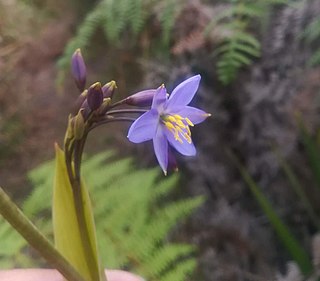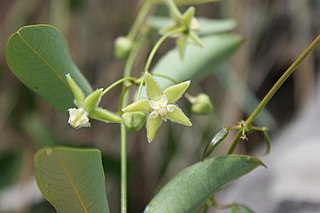
Weinmannia is a genus of trees and shrubs in the family Cunoniaceae. It contains 90 species, which range from Mexico through Central and South America including the Caribbean, and to the Mascarene Islands in the western Indian Ocean. It is absent from mainland Africa and Australia, but some fossils have been attributed to Weinmannia in Australia.

Dracontium is a genus of flowering plants similar to those of Amorphophallus. Unlike Amorphophallus which is found in the Old World, this genus has a New World distribution and is native to South America, Central America, southern Mexico, and the West Indies.
Triuris hyalina is a species in genus Triuris. It is a tiny flowering plant no more than a few cm tall, lacking chlorophyll and obtaining its nutrients from fungi in the soil. It is known from Brazil, Suriname, Guyana, Colombia, Venezuela.
Thoracocarpus is a genus of plants first described as a genus in 1958. It contains only one known species, Thoracocarpus bissectus a hemiepiphytic vine. It is native to Costa Rica, Panama, Cuba, Trinidad and Tobago, and South America.
Aechmea corymbosa is a plant species in the genus Aechmea. This species is native to Venezuela, Colombia, Peru, Brazil and Ecuador.
Guzmania brasiliensis is a plant species in the genus Guzmania. This species is native to northern Brazil, Peru, Colombia, Venezuela and Ecuador.
Tillandsia turneri is a species of flowering plant in the family Bromeliaceae. This species is native to Venezuela, Colombia, Guyana, and northern Brazil.

Amasonia is a genus of plants in the family Lamiaceae, native to South America and to the island of Trinidad.
Euterpe catinga is a palm species in the genus Euterpe. It is found in forests of a dry, sandy soil and very peculiar vegetation, known as catinga forests or Campinarana in northern South America.
Soridium is a genus of parasitic plants in the Triuridaceae, lacking chlorophyll and obtaining nutrients from fungi in the soil. It contains only one known species, Soridium spruceanum, native to Brazil, Venezuela, Suriname, French Guiana, Belize and Guatemala.

Excremis is a genus of herbs in the family Asphodelaceae, first described as a genus in 1829. There are only one known species, Excremis coarctata, native to South America.
Achlyphila is a genus of plants in the Xyridaceae, first described as a genus in 1960. It contains only one known species, Achlyphila disticha, endemic to the Serranía de la Neblina National Park in the State of Amazonas in southern Venezuela, very close to the border with Brazil.

Evodianthus is a genus of plants first described as a genus in 1857. It contains only one known species, Evodianthus funifer, native to Trinidad & Tobago, Central America and northern South America.

Blepharodon is a genus of plant in the family Apocynaceae, first described as a genus in 1844. They are native primarily to South America, with one species extending into Central America and Mexico.
Diploon is a genus of plant in the family Sapotaceae described as a genus in 1946.
Thurnia is a group of herbaceous plants described as a genus in 1883.
Brickellia diffusa is a Latin American species of flowering plants in the family Asteraceae. It is widespread across much of South America, Central America, Mexico, Galápagos, and the West Indies. Its distribution stretches from Sonora and Tamaulipas in northern Mexico to Jujuy in northern Argentina.
Chromolaena squalida is a South American species of flowering shrub in the family Asteraceae. It is found in Brazil, Paraguay, Bolivia, Peru, Colombia, Venezuela, Guyana, Suriname.

Dr. Charlotte M. Taylor is a botanist and professor specialising in taxonomy and conservation. She works with the large plant family Rubiaceae, particularly found in the American tropics and in the tribes Palicoureeae and Psychotrieae. This plant family is an economically important group, as it includes plant species used to make coffee and quinine. Taylor also conducts work related to the floristics of Rubiaceae and morphological radiations of the group. Taylor has collected plant samples from many countries across the globe, including Chile, Colombia, Costa Rica, Panama, and the United States of America, and has named many new species known to science from these regions. As of 2015, Taylor has authored 278 land plant species' names, the seventh-highest number of such names authored by any female scientist.
Paul Edward Berry is an American botanist and curator. He is Director of the Wisconsin State Herbarium.






